Proceedings on non-wood forest products in Central Africa
Non-wood forest products of Central Africa: current research issues and prospects for conservation and development. T.C.H. Sunderland, L.E. Clark and P. Vantomme, eds. 1999. Rome, FAO.
This volume contains the proceedings of the International Expert Meeting on Non-Wood Forest Products in Central Africa, held at the Limbe Botanic Garden, Cameroon, from 10 to 15 May 1998. The workshop, which brought together over 60 regional and international experts, was organized by the United States Agency for International Development (USAID)-funded Central African Program for the Environment (CARPE) with support from the FAO Non-Wood Forest Products Programme.
The publication opens with a summary of the discussions and recommendations of the 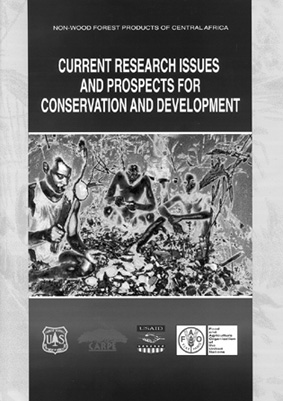 workshop, and then provides,
in full, all of the papers presented. The papers are organized according to the four thematic areas considered by the consultation: ecological issues, socio-political issues, market-economic issues, and networks and information exchange. Taken as a whole, the papers synthesize the current state of knowledge of non-wood forest products (NWFPs) and issues related to their exploitation, and provide a unique overview of the NWFP sector in Central Africa. Moreover, although they focus on Central Africa, the papers have relevance in a much wider context.
workshop, and then provides,
in full, all of the papers presented. The papers are organized according to the four thematic areas considered by the consultation: ecological issues, socio-political issues, market-economic issues, and networks and information exchange. Taken as a whole, the papers synthesize the current state of knowledge of non-wood forest products (NWFPs) and issues related to their exploitation, and provide a unique overview of the NWFP sector in Central Africa. Moreover, although they focus on Central Africa, the papers have relevance in a much wider context.
Two major options for management of NWFPs emerge from the papers presented. The first, domestication and on-farm cultivation, is appropriate when wild resources are being overexploited. The second involves putting systems into place for defining who has access to wild NWFP resources in a given area and for monitoring their exploitation; this option is appropriate when wild resource use is still within sustainable levels. For both options, it is apparent that efforts must be taken to maximize the per-unit value obtained from marketing NWFPs.
This volume, also to be published in French in 2000, will be of interest and use to all those concerned with the conservation and use of NWFPs.
How to meet standards of sustainable forest management
The sustainable forestry handbook.
S. Higman, S. Bass, N. Judd, J. Mayers and R. Nussbaum. 1999. London, Earthscan Publications. ISBN 1-85383-5994.
Despite the development of international and national standards of sustainable forest management, it is not always clear to forest managers, particularly those in the tropical developing world, how to put sustainability principles into practice.
The sustainable forestry handbook provides forest managers with the necessary tools to understand and apply new standards for forest management, in particular those developed by the Forest Stewardship Council (FSC) and the International Tropical Timber Organization (ITTO). These two major international initiatives have been the most extensively promoted by recent market and policy initiatives, especially in the tropics. The handbook also provides an environmental management system framework, based on ISO 14001, to assist implementation of the standards.
The handbook provides the necessary background for understanding, planning and implementing improved forest
management techniques. It gives a method for identifying and carrying out the necessary activities and points
the way to further sources of information. Supported by case studies, it highlights common problems and suggests
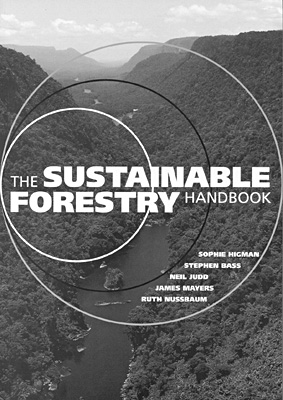 some possible solutions.
some possible solutions.
The handbook discusses international initiatives attempting to define sustainable forest management, forest management certification, legal and policy issues and issues related to sustained timber production, environmental protection and human well-being. A section focuses specifically on plantation management.
It also describes the most recent methods for including all forest stakeholders in the management process. New techniques successfully used in community forest projects and agriculture are described.
The sustainable forestry handbook will be useful for forest managers and forest management teams in tropical developing countries where up-to-date information may be difficult to find. It provides basic and comprehensive guidance on practical methods for meeting international standards. It will be of particular help for forest organizations desiring independent certification of their forest management.
Counting the rings
Tree-ring analysis: biological, methodological and environmental aspects. R. Wimmer and R.E. Vetter, eds. 1999. Wallingford, UK, CABI Publishing (a division of CAB International). ISBN 0-85199-321-5.
The analysis of tree rings has been extremely important in many kinds of environmental studies including assessment of forest decline, ecological prognosis on a large scale and investigation of climate trends over periods ranging from decades to millennia. Knowledge obtained through tree-ring analysis is also valuable in forest management and in the forest products industry.
This book - 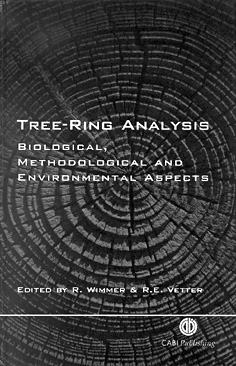 the product of a meeting of the International Union of Forestry Research Organizations (IUFRO)
research group on tree-ring analysis, held in Pullman, Washington, United States in July 1997 - describes the
latest achievements and challenges in tree-ring research from around the world.
the product of a meeting of the International Union of Forestry Research Organizations (IUFRO)
research group on tree-ring analysis, held in Pullman, Washington, United States in July 1997 - describes the
latest achievements and challenges in tree-ring research from around the world.
Nineteen chapters are grouped into five sections. Section A deals with basic aspects of tree-ring growth. Section B focuses on extraction of information from anatomical and structural features such as resin ducts and annual rings in bark. Section C covers tropical tree-ring analysis, including studies on the periodicity of cambial growth in tropical trees and climatic influences. Section D presents the use of tree rings for historical studies. The final section deals with applications in forest monitoring and effects of climate and competition on tree growth.
The book should appeal to professionals in forestry, tree physiology and wood science, and it is also intended to promote networking in the field, with complete contact information provided for all 53 contributors.
The challenge of conserving biological diversity in forests
Maintaining biodiversity in forest ecosystems. M.L. Hunter. 1999. Cambridge, UK, Cambridge University Press. ISBN 0-521-63768-6.
The maintenance of the earth's biological 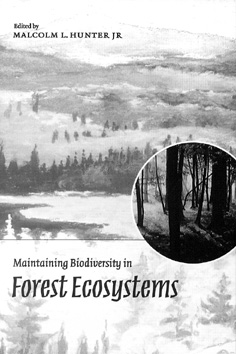 diversity is not only aesthetically desirable, but essential for ecosystem integrity. This book focuses on how biological diversity can be maintained in forested ecosystems, particularly in those forests that are subject to timber harvesting. At the core of the book lies the concept that diversity should be conserved in all its forms, from the smallest microbes to the largest trees, and at all levels of organization, from genes through species to whole ecosystems.
diversity is not only aesthetically desirable, but essential for ecosystem integrity. This book focuses on how biological diversity can be maintained in forested ecosystems, particularly in those forests that are subject to timber harvesting. At the core of the book lies the concept that diversity should be conserved in all its forms, from the smallest microbes to the largest trees, and at all levels of organization, from genes through species to whole ecosystems.
The book's 19 chapters are organized into four sections. An introductory section presents general concepts of biological diversity and sustainable forestry. The two central sections deal with management at the macro (landscape) and micro (stand) levels. The concluding section considers socio-economic and policy perspectives that are at the root of the implementation of successful and sustainable management practices.
Some 33 experts from ten countries have contributed to the book, but with more than half the contributors coming from North America there is a clear bias towards this region. Nonetheless, Maintaining biodiversity in forest ecosystems provides a broad and up-to-date perspective on a topic of increasing importance. It is likely to find wide application as a university text and will also deliver valuable reading for forest managers.
Unlawful timber activities in the tropics
Cut and run: illegal logging and timber trade in the tropics. R. Glastra, ed. 1999. Ottawa, Canada, International Development Research Centre (IDRC). ISBN 0-88936-862-7.
This volume presents the findings of a project carried out in four countries from 1995 to 1997, focusing on a topic inadequately addressed in the existing body of forest information: illegal cutting and trading. The project was initiated by Friends of the Earth International in cooperation with four other non-governmental organizations (NGOs) and was partially funded by the International Development Research Centre.
The book examines not only logging and timber trade activities that violate national or international laws
(above all, illegal harvesting and illegal transfer of funds), but also abuses of power, fraudulent 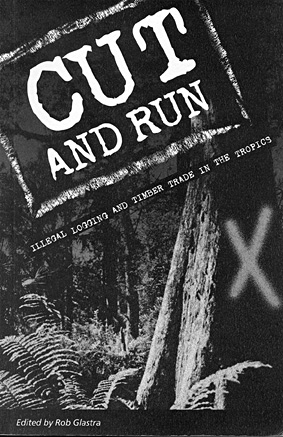 behaviour and
evasion of government restrictions. The book focuses on the cases of four tropical countries - Brazil, Cameroon,
Ghana and Paraguay - but also discusses illegal timber trade on a global scale as well as economic processes affecting the fate of the world's forests.
behaviour and
evasion of government restrictions. The book focuses on the cases of four tropical countries - Brazil, Cameroon,
Ghana and Paraguay - but also discusses illegal timber trade on a global scale as well as economic processes affecting the fate of the world's forests.
It is argued that the production and trade of timber must be regulated in order for sustainable forest management to be possible. Liberalization and the deregulation of global trade, as well as export-oriented aid schemes, push developing countries into selling their natural resources such as timber and undermine regulatory mechanisms. These trends in global trade make it increasingly difficult to place the timber sector under the control that is needed to respond to the global forest crisis. The lack of control, in turn, creates more opportunities for illegal practices.
The exploitation of rural poverty by logging companies is discussed, and it is argued that impoverished citizens of developing countries often have no choice but to accept the wages that logging companies offer them for cutting and hauling logs.
Efforts to address the problems of unsustainability and illegality in the timber trade at the national and international levels are examined. These include certification initiatives and the establishment of the International Tropical Timber Organization (ITTO). It is argued, however, that development agencies have given little attention to illegal forestry activities.
The final chapter presents conclusions and recommendations derived from the four case studies.
From "abiotic" to "zygote", a new reference tool for forestry
The dictionary of forestry. J.A. Helms, ed. 1998. Bethesda, Maryland, USA, Society of American Foresters/Wallingford, UK, CABI Publishing.
ISBN 0-939970-73-2.
The dictionary of forestry is a revision of Terminology of forest science, technology, practice and products, published by the Society of American Foresters (SAF) in 1971. In the intervening years, the forestry profession has substantially shifted its focus from sustained yield of forest products to a broader, more complex goal of sustaining diverse forest uses and values. The resulting modifications in the use of existing terms and the introduction of new ones has created the need for this up-to-date dictionary, which will permit consistent use of professional language.
The dictionary is the product of input from 29 SAF working groups, compiled by a subcommittee of SAF's Forest Science and Technology Board. In accordance with the general guidelines for its development, the dictionary:
- does not aim to duplicate or to provide the depth of more specialized dictionaries and glossaries in the various disciplines of forest science;
- avoids terms that are either self-explanatory or contained in  standard dictionaries;
standard dictionaries;
- does not provide taxonomic details or classification systems;
- amplifies definitions by providing notes that help users interpret the definitions or provide examples of use;
- provides cross-references to allied terms.
For example, the term "habitat", once a single entry, is now also part of six compound terms (habitat conservation area, habitat conservation plan, habitat diversity, habitat fragmentation, habitat quality and habitat type). Entries such as "prong test" (a test to indicate the nature and intensity of the stresses in timber) and "guy derrick" (a tool used for timber transport) have been eliminated, making way for "program evaluation and review technique (PERT)" and "graphical user interface".
The dictionary of forestry should help students, professionals and the public - all those interested in the science, management and conservation of forests - to communicate technically with precision, clarity and consistency. As with all language, the vocabulary of forestry is dynamic, and the terms and definitions compiled here reflect current professional acceptance and use.